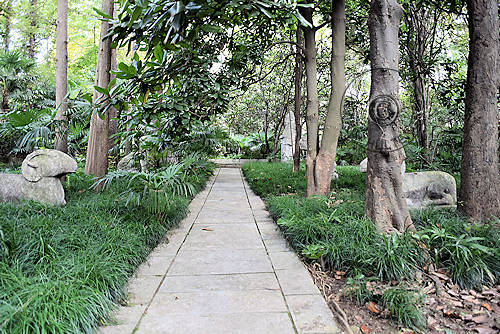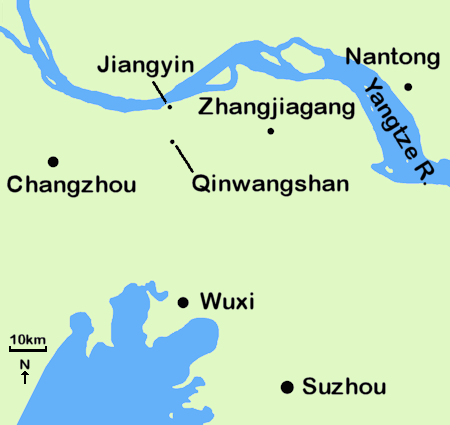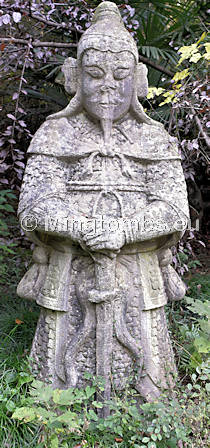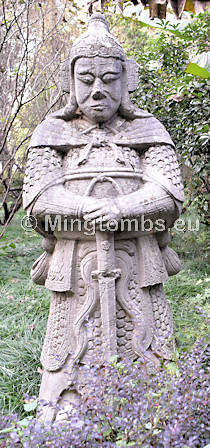Wu Liang ( 1324 - 1381 )
Brothers in Arms

General Wu Liang's Tomb
General Wu Liang, born 1324 in Dingyuan, Anhui Province, was a co-founder of the Han Chinese Ming Dynasty and a trustworthy brother-in-arms of Zhu Yuanzhang, the first Ming emperor. The two first met when Zhu in a lull in the battles against the Mongol Yuan army returned to his hometown to recruit 700 new soldiers. Among them would be 24 future Ming generals and one of these was Wu Liang.
He rose from commander to general during the revolt against the Yuan Dynasty and in the battles for supremacy with competing local warlords around the Yangtze River.
One of Wu Liang's best known achievements was his brave command of the troops that defeated a strong army of local warlord Zhang Shi Cheng around the city of Jiangyin (same name today) in Jiangsu Province. Jiangyin is located some 35-40km north of Wuxi and about 70km north of Suzhou, Zhang Shi Cheng's power base.
The Battle for Jiangyin
In June 1357 Zhu Yuanzhang dispatched troops to expel Zhang Shi Cheng's troops from their stronghold in Jiangyin. Occupying part of the southern bank of the Yangtze River, the location played a significant strategic role in controlling naval- and civilian river traffic between Nantong and Nanjing.

Zhu placed Zhao Ji Zu, a member of the prestigious Privy Council, in charge of the detachment and ordered Marshall Guo Tian Lu together with Commander Wu Liang to spearhead the troops.
Zhang Shi Cheng had wisely placed his main army on the easily defensible Qinwangshan mountain some 10km south of Jiangyin. From there they could both ambush troops attacking Jiangyin and also act as reserve troops for those holding the city.
But taking advantage of inclement weather conditions and natural landscape features Commander Wu Liang managed to defeat Zhang Shi Cheng's army and take the mountain. Moreover, the defeated soldiers fled in disarray so that only few of them managed to escape to Jiangyin to assist in the upcoming defense of city.
On June 16, Zhu Yuanzhang's troops commenced the attack on Jiangyin focusing their forces on the west gate of the city wall. After fierce battles lasting through the night, they successfully entered the city on June 17 and ousted the last defenders. Jiangyin had fallen and Zhu Yuanzhang now controlled the all important Yangtze River traffic.

In appreciation of Wu Liang's leadership and pivotal role in the successful battle, Zhu promoted him to general and made him a member of the prestigious Privy Council. He also made him Commander-In-Chief of the Ming troops that were to defend Jiangyin from the anticipated attempts by Zhang Shi Cheng to recapture the city.
"The Prince"
General Wu Liang returned to Jiangyin and soon proved that in addition to his military skills he was also a benevolent leader and capable administrator.
The citizens were left to go about their daily chores and he enforced a strict code of good conduct by which his soldiers in no way would harass or take undue advantage of the citizens. Also, his soldiers were made to partake in farming so as not to deprive the locals of their food stores.
The battles had taken their toll on Jiangyin city so Wu Liang commissioned repairs, but not only to the military fortifications but also to the local infrastructure improving peoples' life.
Spy or Fairy Tale ?

In Chinese legend, Zhu Yuanzhang sent Wu Liang to Beijing in order to spy on the occupying forces of the Mongolian army.
He managed to infiltrate the city and to gather useful intelligence crucial for the upcoming attack on the city led by Zhu's son, Zhu Di, the later Yongle Emperor (r.1403-24).
But on his way out of Beijing he was spotted by the Mongolians, who set off in hot pursuit.
Wu Liang fled through the streets but was eventually trapped inside a hutong. The entire hutong was quickly surrounded by the Mongolians and they started a house-to-house search.
Inside the hutong Wu Liang met an old Chinese man with a long, white goatee. He told Wu Liang how to escape from the hutong despite it being surrounded and, following the advice, Wu Liang managed to slip out and leave Beijing unharmed.
This is allegedly one of the main reasons why the hutong was named after Wu Liang (see text).
The truthfulness of the legend is questionable, since there is no record of Wu Liang ever having been in Beijing, but it makes for a good tale.
In his spare time he engaged with local scholars and took an interest in expanding learning institutions by for instance repairing public schools and building many more community schools.
With great vigilance he successfully defended the city against counterattacks thereby maintaining Ming's control of river traffic.
Wu Liang - A Nobleman
In 1370 Zhu Yuanzhang took stock of all his highest ranking people and bestowed them hereditary nobility titles commensurate with their status in the Ming Dynasty. Six people were awarded the rank of duke and 28 generals the rank of marquis.
Wu Liang was one of these latter generals, but in addition he was awarded the honor to have his tomb situated on the same mountain where the Emperor's mausoleum was being constructed.
Wu Liang's name and reputation reverbarated all the way to Beijing! One of the hutongs in the eastern district of Beijing, the new capital of the third Ming ruler, the Yongle Emperor (r.1403-1424), was named after Wu Liang. In the 15th Century it was called "His Excellency Wuliang Alley", but today it carries the name of the "Red Star Hutong". See also inserted box above.

The tomb is well concealed in the trees straight ahead
Wu Liang's mausoleum has been completely swallowed up by some residential buildings in Nanjing. In fact, if you don't already know where it is, you are not very likely to locate it - even if you can find your way to the residential compound.
Once you manage to locate and gain access to the compound then proceed along the main road until you reach the left bend (see image). Veer off the road right and you will see the entrance marked with a plague offering some details of Wu Liang. At that spot you will also be able to see some stone figures almost buried in the foilage.

Missing tablet
Inside the mausoleum you will pass a line of stone figures. First, a turtle tablet except the tablet has gone missing. The stone turtle sits a little off to the side from the main path and has its own access path.

After a small left turn bend you will pass two horses, two rams, two tigers and two generals. Apart from the turtle, the pairs are lined up on each side of a narrow "Sacred Way" leading up to the burial place.
The figures show clear outcome of natural wear and tear plus modern days' pollution. They are mostly intact except for the horses, where pieces are missing, and - as mentioned above - the turtle, where the stone tablet on its back has been lost.

Horse with Attendant
All the stone figures are smaller those you found in the imperial mausolea of the same period, the Hongwu reign (1368-1398). They are however of similar size to those found in the other Ming noblemen's mausolea around Zhongshan Mountain in Nanjing.
The horse is fully saddled up and held at the ready by an attendant. The lower arm of the attendant and the reins are missing on the eastern statue. The attendants' outfits have no decorations and are held in place by a simple rope.
The statues are mirrored so that both the attendants stand on the side of the horse that faces the actual tomb.


The rams are both in a lying position. The eastern figure is in a better shape than the western one where some contours have faded over time. The deatils of the horns and ears are however still quite distinguishable on both figures with the hooves a little less so.

smiling?
Next on the path are the tigers, both in a squatting position. Their tails are neatly curled up and they almost appear to be amused. One can still trace decorations or patterns on their bodies, but the finer masonry details have been lost many years ago.
In Asia tigers are considered protectors of the dead and thus a logical placement in a mausoleum.

Eastern General

Western General
The two generals are the last statues flanking the "Sacred Way" and closest to the tomb platform.
Apart from some facial features they are quite similar. However, the western statue appears in much better condition than the eastern one, which could indicate that it could have been replaced at some point in time.
Both generals wear a traditional military officer outfit and they stand with hands folded over the handle of their sword, which again is vertically resting on the ground. They are clearly ready for battle or, in this case, prepared for defending the tomb against unwanted intruders.
The western - and possibly newer - statue is beardless whereas the eastern general has a goatee. Also the facial expression and features on the western statue are more distinct than its counterpart.

Tomb platform
The tomb platform is rather simple. The two low level platforms do not carry any stairs and they are not adorned with any kind of decoration. Similarly, as could be expected, there is no stone altar with sacrficial vessels, which normally would be found in imperial Ming mausolea but not in those of Ming generals or noblemen.
There is no trace of a tomb mound behind the platforms. In various material one can find diagrams of what General Wu Liang's underground tomb looks like, but a visit to this location will not shed any light on that.